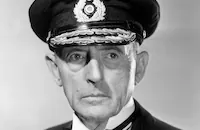The twisting plot of Background to Danger was based on a novel by Eric Ambler called Uncommon Danger. Considered one of the pioneers of the modern, political thriller, Ambler published nineteen solo works during his career and collaborated on four more books under the pseudonym Eliot Reed. Ambler got his start in show business at a very early age. His parents were entertainers, and Ambler's first writing gigs were plays performed in the English music halls. He'd already published four novels, The Dark Frontier, Uncommon Danger, Epitaph for a Spy and Journey Into Fear, by the time he got his first job in the film industry as a script consultant for English producer Alexander Korda. During WWII, Ambler was assigned to a combat photography unit in Italy and eventually became assistant director of British army cinematography. In this position, he wrote and produced almost one hundred training and propaganda films. Ambler's jump to the big screen came in 1943 with the adaptation of his novel Journey Into Fear. The movie, produced by RKO and Orson Welles' Mercury company, starred Welles and usual Mercury Players: Joseph Cotten, Dolores del Rio and Agnes Moorehead. Welles was also slated to direct Journey Into Fear, but the project was taken out of his hands and given to Norman Foster who finished the job. (Foster's best remembered directing credits include eight Mr. Moto movies, several Charlie Chans and later, episodes of the Batman TV series).
Background to Danger became Ambler's second page to screen adaptation. And aside from a few shifts in locale, the movie remained quite faithful to Ambler's novel. Since the book was written in 1937, before the outbreak of WWII, the villain in the film was also changed. In Ambler's story, American spy Joe Barton battles the Pan Eurasian Petroleum Co. But in 1943, such a villain hardly seemed nefarious, and accordingly, the screenplay pitted Raft against Hitler and the Nazis.
As a movie, Background to Danger had some pretty big shoes to fill. Warner Bros. had high expectations for it, seeing the project as a follow up to Casablanca (1942). The studio hoped the film could recreate the atmosphere and the success of the Bogart-Bergman hit. It was also a chance for George Raft to play a character like Rick in Casablanca -- a role he'd been offered and turned down. From the start, the Casablanca influence is apparent in Background to Danger. The movie uses the same kind of opening as Casablanca - a close-up of a map - to establish the setting and the history. It also features a similar story; this time it revolves around missing war plans instead of letters of transit. And once again, there's plenty of patriotic moments, but in place of a rousing rendition of "Les Marseilles," Background to Danger delivers a recitation of the Gettysburg Address. The ending of
Clearly Background to Danger never quite lived up to the legendary status of Casablanca, but it wouldn't be Ambler's last movie adaptation. The Mask of Dimitrios (1944), based on a novel by the same title and once again starring Sydney Greenstreet and Peter Lorre, was perhaps Ambler's most successful book based movie. Topkapi (1964), adapted from a book called The Light of Day, also proved to be a popular hit. But Ambler's movie ventures were not limited to adaptations. He penned several scripts not based on his books, including the Gregory Peck WWII war-adventure The Purple Plain (1954) and The Cruel Sea (1953) for which Ambler would receive an Oscar nomination for Best Original Screenplay.
Producer: Jerry Wald
Director: Raoul Walsh
Screenplay: W.R. Burnett, based on the novel by Eric Ambler
Cinematography: Tony Gaudio
Costume Design: Milo Anderson
Film Editing: Jack Killifer
Original Music: Frederick Hollander
Principal Cast: George Raft (Joe Barton), Brenda Marshall (Tamara), Sydney Greenstreet (Col. Robinson), Peter Lorre (Nikolai Zaloshoff), Osa Massen (Ana Remzi Baronvitch), Turhan Bey (Hassan), Willard Robertson (McNamara), Steven Geray (Raeder), Pedro de Cordoba (Old Turk).
BW-81m.
By Stephanie Thames




































